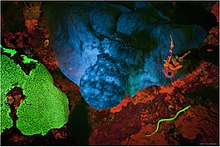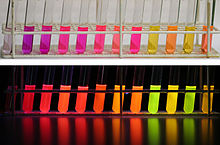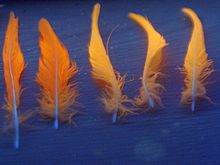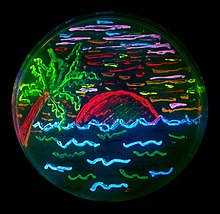fluorescence

Fluorescence ( fluorɛsˈt͜sɛnt͜s ) is the spontaneous emission of light shortly after a material is excited by light. The emitted photons are usually lower in energy than those previously absorbed. Physical systems in which fluorescence occurs are called fluorophores . Fluorescent substances that are used for coloring are called fluorochromes or fluorescent dyes . If the stimulable material is part of an organism, it is also called biofluorescence (in analogy to bioluminescence ). If an object is fluorescent by itself, i.e. without having to be colored, one speaks of autofluorescence or self-fluorescence .
In contrast to phosphorescence , permissible transitions between two electronic states occur with fluorescence . The excited states therefore have a short lifespan and the fluorescence decays after a short time.
The term fluorescence (originally "fluorescence") was introduced in 1852 by George Gabriel Stokes . The word is derived from the sometimes fluorescent mineral fluorite (fluorspar, calcium fluoride, CaF 2 ).
Phosphorescence and fluorescence
Both fluorescence and phosphorescence are forms of luminescence (cold glow) and are photophysical processes .
However, fluorescence is characterized by the fact that it ends quickly (usually within a millionth of a second) after the end of the irradiation. With phosphorescence, on the other hand, there is an afterglow that can last from fractions of a second to hours.
Explanation
If the fluorophore is optically excited, i.e. by the absorption of a photon , and then deactivated with the emission of light, this is called photoluminescence .
The excited fluorophore remains in the excited state for a certain time after absorption. This time is generally referred to as the lifetime or, in particular, also as the fluorescence lifetime . According to the rules of quantum mechanics, the fluorescence lifetime is short because the light emission is "allowed" and therefore takes place quickly. The background to this is that there is no need to reverse the spin when returning to the basic state. The emission of fluorescent light competes with other photophysical processes (internal conversion, intersystem crossing), which weaken the fluorescence. The probability with which the excitation of a fluorophore actually leads to the emission of a fluorescence photon is called the fluorescence quantum yield .
The emitted fluorescent light is usually shifted into the long-wave range of the light spectrum compared to the excitation light. This effect is called Stokes' rule . The effect is based on the fact that with the electronic excitation, higher oscillation states of the excited state are occupied first, which then release their energy through oscillation relaxation. Likewise, during emission (from the vibrational ground state of the excited state), higher vibrational states of the ground state are often occupied first. In general, therefore, more energy is expended for excitation (shorter wavelength) than is emitted during emission (longer wavelength). The law of conservation of energy is not violated because the differential energy was given off to the environment (vibration relaxation). In the borderline case, of course, excitation and emission can occur between the basic oscillation states of the excited and basic state. In this case, excitation and emission occur with the same wavelength and one speaks of resonance fluorescence .
Deactivation
Non-radiative deactivation processes can be promoted by the presence of certain substances, so-called quenchers . The phenomenon that these competing processes reduce the fluorescence is referred to as fluorescence quenching ( quenching hereinafter). An important quencher, especially for the fluorescence of organic fluorophores, is molecular oxygen (O 2 ). This is based on methods for determining the mass concentration of oxygen in the sensor system (oxygen sensor), e.g. B. to monitor the oxygen concentration in the air . The dependence of the fluorescence quantum yield on the concentration of a quencher is often well described by the Stern-Volmer equation .
In an alternative, non-radiating process, the excited state can change its multiplicity to the usually energetically lower-lying triplet state (exception: e.g. molecular oxygen ) through a so-called intersystem crossing . From here, in turn, various deactivation channels are open, with the radiating, i.e. H. Light-emitting, known as phosphorescence .
Fluorescent substances (selection)

V. l. right: 1. water , 2. methanol , 3. ethanol , 4. acetonitrile , 5. dimethylformamide , 6. acetone , 7. ethyl acetate , 8. dichloromethane , 9. n- hexane , 10. tert -butyl methyl ether , 11. cyclohexane , 12. Toluene
- Allophycocyanin
- Berberine
- Brilliant sulfaflavin
- quinine
- Coumarins , e.g. B. 4-methylumbelliferone
- DAPI
- 1,3,2 dioxaborines (complexes of boric acid derivatives with 1,3-dicarbonyl compounds)
- Epicocconon
- Fluoresceins (e.g. 5-octadecanoylaminofluorescein , 6-carboxy-4 ′, 5′-dichloro-2 ′, 7′-dimethoxyfluorescein-N-succinimidyl ester )
- Fluorescent proteins (GFP, YFP, RFP)
- IAEDANS
- Indocyanine green
- Sodium diuranate
- Nile blue / Nile red
- Porphyrins ( heme , chlorophyll , etc.)
- Quadraine ( squaric acid dyes ) based on N, N-dialkyl anilines
- Rhodamine
- Stilbene
- Synthetic fluorescent labels or markers such as B. ATTO-Dyes (ATTO-TEC GmbH, Siegen), Alexa-Fluor (Molecular Probes, Invitrogen Corp.) and Cyanine (Cy3, Cy5 etc.)
- TMRM +
- other dyes: in the fluorescent dye category
Occurrence
Cosmic rays
High-energy cosmic radiation triggers particle cascades, so-called extended air showers, in the earth's atmosphere. The charged particles of these showers excite the nitrogen molecules in the air so that they emit fluorescent light. By measuring this light, conclusions can be drawn about the primary cosmic radiation. Similar phenomena are the polar light , in which the air molecules are primarily excited by the particles of the solar wind , and the radiation from the glowing comet's tail , in which molecules emit light as a result of the interaction with the solar wind.
Mineralogy, gemology (gemology)
Minerals , gemstones , fibers and many other materials that are examined in collectibles and antiques have different fluorescence properties when irradiated with short- or long-wave UV light or with X-rays and can thereby be identified.
Fluorescence is also used in paleontology to find and examine numerous fossils.
Biofluorescence
Biofluorescence, fluorescence from organisms, is known in cat sharks . There are current film recordings that show biofluorescence (distributed over the whole body), which can only be detected with special light. Fish, especially small, bottom-bound marine fish and various coral fish from different families ( above all Gobiidae , Tripterygiidae , Labridae and others) have red fluorescent patterns as part of their body color or red fluorescent eyes. This is a trick to convert this into a noticeable red glow in deeper water, where blue-green ambient light dominates. Little is known about the exact mechanisms and functions of this fluorescence. John S. Sparks devoted himself a. a. research into bioluminescence in marine fish.
The cuticle of the scorpion fluoresces when exposed to UV light. Embedded beta-carbolines and 7-hydroxy-4-methyl coumarin are stimulated. This effect is retained even after the animals die. With the help of appropriate lamps, the animals can therefore be easily spotted in the dark.
Bird feathers can also show biofluorescence. Some parrots have feathers that show sulfur-yellow fluorescence. In normal light these feathers (if they are not overlaid by other pigments) are pale yellow. The eyesight of birds, which often have tetrachromatic eyes , extends into the UV range. Here, fluorescence darkens the light reflected in the UV range. Under normal lighting conditions this fluorescence is too weak to be noticed.
application areas
Some methods and areas of application are listed below:
Fluorescence spectroscopy
The term fluorescence spectroscopy summarizes methods that use the fluorescence properties of fluorophores to obtain information about the systems under investigation. There are many natural and synthetic compounds that exhibit fluorescence. The composition of a sample can therefore be determined with the help of spectroscopy.
→ See also: fluorescence correlation spectroscopy , fluorescence polarization , fluorescence tomography , fluorescence microscopy .
Brightening and decoration
By absorbing (invisible) ultraviolet and blue light and emitting longer-wave visible light, brightening can be achieved:
- optical brighteners
- Signal color ( daylight color )
- Highlighter (fluorescent color)
As early as the 19th century, there were reports about the fluorescence of esculin or watery extracts from horse chestnut bark irradiated by sunlight . The German chemist Paul Krais (1866–1939) investigated this effect by adding aesculin-containing extracts of horse chestnut to wool and flax, thereby achieving an optical brightening.
So-called black light ( UV light , UV-A) is often used in discos to illuminate fluorescent colors, beverages containing quinine or optical brighteners in clothing. Blackboards that can be written on with fluorescent chalk are also known. They can be illuminated from the outside or from the inside ( floodlight ) through the transparent board material with ultraviolet.
Daylight color already fluoresces through the excitation with the blue component of daylight. Since this is particularly high in bad weather and at dusk, better visibility is achieved. Fluorescent paint is also available in water-soluble form.
lighting

In fluorescent lamps, ultraviolet light, which is generated by gas discharge in the tube filled with mercury vapor , is converted into visible light. In white light emitting diodes (LEDs), fluorescent dyes that are similar to these phosphors convert the monochromatic blue light that a semiconductor crystal produces into polychromatic white light.
Technical fluorophores consist of substances such as the very frequently used zinc sulfide and chemically similar compounds or oxides of the rare earth metals . If these compounds are doped with so-called activators , different colors can be produced. As activators are often di- and trivalent lanthanide - cations used. For example, divalent europium cations produce blue light, while the trivalent europium cations emit red light . Green light is produced, for example, by Cu + and Al 3+ -doped zinc sulfide.
A large spectrum of usable light wavelengths and color temperatures can be realized through a suitable composition (mixture) of the phosphors , whereby the illuminant can be adapted to the respective application. In fluorescent lamps z. B. depending on the luminous gas used, the spectrum of sunlight (cold white) or that of an incandescent lamp mimicked.
Also tritium gas light sources utilize the fluorescence of a phosphor represented by the beta radiation of tritium is stimulated.
Ads, displays and screens
In displays, displays and screens, the excitation of fluorescent dyes is often used by electron bombardment ( cathode ray tubes ). Examples are vacuum fluorescence displays ( Digitron ), cathode ray tube screens ( English Cathode Ray Tube - CRT) and tuning indicator tubes ( magic eye ).
What they have in common is the release of electrons through glow emission in a vacuum and their acceleration onto a phosphor layer through an electrical voltage . The shadow cross tube and field emission microscopes used for demonstration purposes , on the other hand, have cold cathodes , and image converter tubes accelerate the electrons generated on a photocathode and produce an image on a small fluorescent screen .
Application in biochemistry and medicine
Fluorescent chemical groups can be attached to large biomolecules by means of a fluorescent label, which then serve as a very sensitive marker for this molecule.

Application examples are:
- When the DNA is automatically sequenced using the Sanger method , each of the four terminating nucleobases of a piece of DNA has its specific fluorescent marker. When the labeled DNA molecules are separated, the markers are excited by UV light and the identity of the markers is determined from the wavelength of the emitted light.
- The compound ethidium bromide shows hardly any fluorescence when it can freely change its conformation in a solution . However, binding to DNA greatly increases fluorescence, making it useful in locating fragments of DNA, e.g. B. in agarose gel electrophoresis .
- The amino acids tryptophan , tyrosine and phenylalanine fluoresce when excited by UV light , and fluorescence can also be observed in proteins and peptides that contain these amino acids .
- Fluorescence is used for detection on DNA chips and protein chips .
- In immunology , antibodies are given a fluorescent chemical group. Molecules to which these antibodies specifically bind can be recognized by means of the fluorescence and can thus - e.g. B. in a cell - can be precisely localized. The concentration of these molecules ( antigen concentration) can even be determined quantitatively (see immunohistochemistry ).
- The fluorescence of porphyrins (components or precursors of heme and chlorophyll ) can be used to diagnose metabolic diseases of heme formation and the chlorophyll fluorescence to determine photosynthetic activity. Porphyrins are also used for the in vivo diagnosis of epithelial tumors and precancerous diseases :
- Since heme in living beings is synthesized from porphyrins, which fluoresce when appropriately stimulated, quantitative measurements in blood, stool and urine samples are possible using high-performance chromatographic methods ( HPLC ) and thus statements about metabolic processes in heme biosynthesis.
- During photosynthesis in organisms, chlorophyll is used to convert photons into chemical energy. By analyzing the chlorophyll fluorescence one can make statements about the condition of the photosystem II and in the context of environmental protection z. B. investigate the degree of damage to forests.
- The fluorescence diagnostics (FD) using protoporphyrin IX (PpIX), which accumulates selectively in or on tumor cells. The fluorescence from PpIX can then be used in dermatology and urology to localize tumors.
- Fluorescent proteins such as GFP ( Green fluorescent protein ) or FMN-binding fluorescent proteins serve as markers or labels for a wide variety of molecules and cell areas ( cell membrane , cytoplasm , cell nucleus , etc.). With suitable microscopic methods, such as. B. confocal fluorescence microscopy , biological processes within the cells can be made visible.
- The distance-dependent activation of a fluorescent acceptor after excitation of a neighboring donor by FRET ( Förster resonance energy transfer ) is used in biochemistry and cell biology for distance measurements in the nanometer range, as well as for the investigation of protein folds .
- Labeling of proteins for differential 2D- PAGE (2D-DIGE)
- FACS ( fluorescent activated cell sorter or flow cytometry )
- FISH ( fluorescence in situ hybridization ) chromosome analysis
- Observation of single molecules by means of single molecule fluorescence spectroscopy
- The vital fluorescence double staining is used to differentiate between living and dead cells.
- TRFIA = time-resolved fluoroimmunoassay. Eu 3+ ions only fluoresce briefly in water. For this reason, chelating agents are used which build up a hydrophobic environment around the Eu 3+ ions . This leads to a longer duration of the fluorescence. This enables a distinction to be made from all other, shorter-lived fluorescences that can occur in organic mixtures.
In forensics , the properties of proteins and their fluorescent effect on certain wavelengths of light are also used in order to be able to recognize blood , saliva , urine or sperm . Since these substances are not always visible to the eye in daylight , lights are equipped with special filters to make specific proteins glow depending on the body fluid . For better detection of the fluorescent protein traces, glasses with a broadband filter are used, which mask the disturbing background fluorescence and scattered radiation .
In the fruit industry , mold can be detected under UV light.
Visual arts
The use of fluorescent colors is a stylistic feature in psychedelic art and in contemporary light art .
See also
- Parametric fluorescence
- (Sensitized) chemiluminescence
Web links
- Fluorophores.org - database for fluorescent dyes TU Graz
- Fluorescence Spectra Viewer Invitrogen Corp.
- Fluorescence . In: Mineralien Lexikon
- Sodium resonance fluorescence LP (LehrPortal) of the Georg-August-Universität Göttingen
- Light microscopy and fluorescence University of Vienna
- Fluorescence Microscopy Extensive interactive tutorial (Engl.)
- Technology to observe the marine bio-fluorescence Organism (Engl.)
- Biological significance of the bio-fluorescence of marine organisms (German / English)
- scinexx.de: Luminous nature - The secret of biofluorescence August 30, 2019
literature
- Werner Lieber: Shining Crystals - Things worth knowing about fluorescence , Vetter Verlag, Wiesloch, 48 S., 1965 (pdf 15MB) .
- Werner Lieber: The fluorescence of minerals , 5th special issue for the journal "Der Aufschluss", VFMG Heidelberg, 62 p., 1957, (pdf 20MB) .
Individual evidence
- ^ GG Stokes: On the change of refrangibility of light. In: Phil. Trans. 142, 1852, pp. 463-562.
- ↑ David F. Gruber, Ellis R. Loew, Dimitri D. Deheyn, Derya Akkaynak, Jean P. Gaffney, W. Leo Smith, Matthew P. Davis, Jennifer H. Stern, Vincent A. Pieribone, John S. Sparks: Biofluorescence in catsharks (Scyliorhinidae): Fundamental description and relevance for Elasmobranch visual ecology. In: Sci. Rep. Volume 6, 2016, p. 24751, doi: 10.1038 / srep24751 .
- ↑ TV report on ServusTV on May 25, 2016.
- ↑ Nico K. Michiels et al .: Red fluorescence in reef fish: A novel signaling mechanism? 2008, accessed March 14, 2011 .
- ↑ P. Chakrabarty, MP Davis, Wm. L. Smith, R. Berquist, KM Gledhill, LR Frank, JS Sparks: Evolution of the light organ system in ponyfishes (Teleostei: Leiognathidae). In: J. Morphol. 272, 2011, pp. 704-721. doi: 10.1002 / jmor.10941
- ↑ JC Poggendorf (Ed.): Annalen der Physik. Volume 4, Verlag JA Barth, Leipzig 1854, p. 313.
- ↑ HJ Meyer (Ed.): New Konversations-Lexikon - A dictionary of general knowledge. Volume 6, Verlag Bibliographisches Institut, Hildburghausen 1863, p. 936.
- ↑ Optical brighteners: history and groups of substances . D. Weiß Online, Institute for Organic Chemistry and Macromolecular Chemistry, Friedrich Schiller University Jena.
- ↑ Ilya A. Osterman, Alexey V. Ustinov, Denis V. Evdokimov, Vladimir A. Korshun, Petr V. Sergiev, Marina V. Serebryakova, Irina A. Demina, Maria A. Galyamina, Vadim M. Govorun, Olga A. Dontsova : A nascent proteome study combining click chemistry with 2DE . In: Proteomics . tape 13 , no. 1 , January 2013, p. 17-21 , doi : 10.1002 / pmic.201200393 , PMID 23161590 ( cyandye.com [PDF]). A nascent proteome study combining click chemistry with 2DE ( Memento of the original from June 30, 2015 in the Internet Archive ) Info: The archive link has been inserted automatically and has not yet been checked. Please check the original and archive link according to the instructions and then remove this notice.
- ↑ Mark Patrick Vogel: Detection of forensically relevant traces with the help of the light source Superlite 400. Dissertation. Ludwig Maximilians University, Munich 2008.






